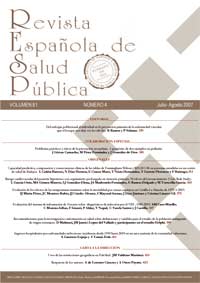Evaluation of the surveillance system for Human Immunodeficiency Virus Infections of Navarra, Spain, 1985-2003
Abstract
Background: Navarra has an information system of HIV diagnoses working since the beginning of the epidemic up to the present day. This study aims at describing and evaluating this system, focusing on its sensitivity. Methods: The updated guidelines for evaluating public health surveillance systems from the CDC were used to describe the purpose and operation of the system and to analyse its attributes for the period 1985-2003. For the evaluation of the sensitivity the regional database of antiretrovirals distribution was used. Results: The HIV surveillance system of Navarra is confidential and name-based, and includes all HIV-infection cases diagnosed each year. The information sources of the system are: a) all the laboratories in the public health system that perform the western blot test, and b) hospital discharge registries. The system covers the entire population of Navarre (584,734 inhabitants). It uses the HIV case definition proposed by the European Centre for the Epidemiological Monitoring of AIDS. The system is well-accepted by the community and by all the stakeholders, including those providing data. By the end of 2003 it included 2,302 HIV cases, and 98.8% of all patients who had ever received antiretrovirals in Navarra. Conclusions: The HIV information system of Navarra is simple, useful, well-accepted and highly sensitive. The information about antiretroviral distribution was useful for this evaluation.Downloads
Published
2008-03-14
Issue
Section
ORIGINALS

